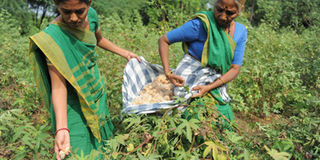The future of cotton is not in genetically modified version

Farmers pick brown cotton in a farm near Ahmedabad. Kenya’s cotton sector is generally characterised by about 140,000 smallholder farmers with a low average yield of 0.53 tonnes of seed cotton per hectare, according to the World Bank. FILE PHOTO | NMG
What you need to know:
- Kenya’s cotton sector is generally characterised by about 140,000 smallholder farmers with a low average yield of 0.53 tonnes of seed cotton per hectare, according to the World Bank.
- The average production of 18,000 tonnes per year over the period 2005-2010 represents a mere 9 per cent of the country’s potential.
- Kenya is at crossroads on whether to allow GM cotton or not. It would, therefore, be incisive to draw parallels with the experiences of Burkinabe and Indian small-scale farmers who have already commercialised it.
- Consequently, cotton should in fact be viewed as a food and feed crop and the government must ensure that consumer safety is prioritised before any consideration of commercialisation of genetically modified cotton.
Cotton is mainly grown for its fibre, which accounts for about 35 per cent weight of the primary product known as seed cotton.
The seed is the main by-product, which accounts for about 65 per cent. The seed is then used to produce four main products namely cotton seed oil, cake, and hulls for livestock feeds, and linters used for other products as film, plastics.
Kenya’s cotton sector is generally characterised by about 140,000 smallholder farmers with a low average yield of 0.53 tonnes of seed cotton per hectare, according to the World Bank.
The average production of 18,000 tonnes per year over the period 2005-2010 represents a mere 9 per cent of the country’s potential.
Amongst the key challenges faced by the sector are poor agronomic practices, inadequate extension services, high cost, and poor quality seed.
The pest pressure of the African cotton bollworm is not mentioned as a key challenge because Bt cotton has been developed targeting this pest.
In terms of regulation, conditional release has been granted for (GM) Bt cotton to Kenya Agricultural Livestock Research Organisation (Kalro) and Monsanto by National Biosafety Authority (NBA).
However, an environmental impact assessment report is still pending from the National Environmental Management Authority.
Kenya is at crossroads on whether to allow GM cotton or not. It would, therefore, be incisive to draw parallels with the experiences of Burkinabe and Indian small-scale farmers who have already commercialised it.
Bt cotton was claimed to be resistant to the most common pest of cotton in India, the pink bollworm. In 2006, just four years after its release by Monsanto, the pink bollworm had become resistant to it in Western India.
Rapid development of resistance occurs because Bt cotton plants are engineered to continuously release toxins, and this constant, long term exposure encourages the survival of any pests that are genetically resistant to the toxin.
POOR QUALITY
As a result, the usage of insecticide on cotton increased from a reported 0.5kg per hectare in 2006 to 1.20kg in 2015 in India.
The cost of proprietary GM seed in Burkina Faso was $45 (Sh4,500) per bag compared to $1.25 for conventional cotton seed.
This trend has been observed in India and South Africa and has a high likelihood of being replicated in Kenya. On claims that Bt cotton has increased yields, from 2007 to 2016, yields stagnated as production rose from 67 to 92 per cent and eventually declined in 2016-17.
The cotton was officially approved in 2002 by Mahyco Monsanto Biotech (India) Ltd, a joint venture between Mahyco Seeds and Monsanto India, which also supported its rolling out by an aggressive advertising campaign.
There is no hybrid seed for cotton available in Kenya and the last variety bred was in 1989 which was a multiline.
Current cotton seed is from ginneries and is of poor quality. The national demand for seed cake surpasses its domestic production, which suggests that there is a domestic market opportunity for both oil and animal feed production, which will in turn spur growth in the country’s cottonseed subsector.
Consequently, cotton should in fact be viewed as a food and feed crop and the government must ensure that consumer safety is prioritised before any consideration of commercialisation of genetically modified cotton.
Evidence has also pointed to farmer suicides increasing with area under Bt cotton. In the Vidarbha region of Maharashtra province, factors linked to its cultivation are reported to have led to 7,992 farmer suicides between 2006 and 2011.
Today, it is clearer that Bt cotton’s benefits claims are exaggerated and now it’s rejection is not only from civil society voices, but official government ones as well.
As a result of the challenges experienced by Burkina Faso between 2011 and 2016 where it lost $82.4 million, it has now implemented a complete phase out of GM cotton for the 2017/18 season. Certainly, the future of the crop is not Bt cotton.
Wanjiru Kamau is the Informaton and Policy Manager of Kenya Organic Agriculture Network (KOAN) ([email protected]) and Rohit Parakh coordinates India For Safe Food ([email protected])





